R语言生存分析大全
- 格式:docx
- 大小:47.91 KB
- 文档页数:21
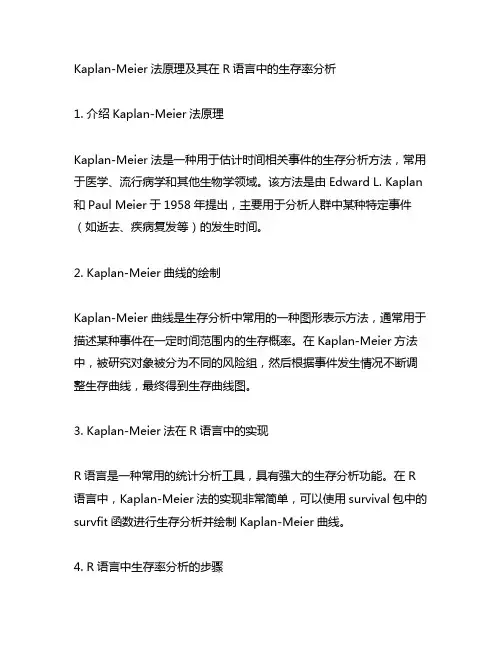
Kaplan-Meier法原理及其在R语言中的生存率分析1. 介绍Kaplan-Meier法原理Kaplan-Meier法是一种用于估计时间相关事件的生存分析方法,常用于医学、流行病学和其他生物学领域。
该方法是由Edward L. Kaplan 和Paul Meier于1958年提出,主要用于分析人群中某种特定事件(如逝去、疾病复发等)的发生时间。
2. Kaplan-Meier曲线的绘制Kaplan-Meier曲线是生存分析中常用的一种图形表示方法,通常用于描述某种事件在一定时间范围内的生存概率。
在Kaplan-Meier方法中,被研究对象被分为不同的风险组,然后根据事件发生情况不断调整生存曲线,最终得到生存曲线图。
3. Kaplan-Meier法在R语言中的实现R语言是一种常用的统计分析工具,具有强大的生存分析功能。
在R 语言中,Kaplan-Meier法的实现非常简单,可以使用survival包中的survfit函数进行生存分析并绘制Kaplan-Meier曲线。
4. R语言中生存率分析的步骤进行生存率分析的步骤如下:- 导入数据:首先需要导入需要进行生存率分析的数据集,通常包括时间、事件发生情况以及其他相关变量。
- 进行生存率分析:使用survfit函数对数据进行生存率分析,得到各个时间点上的生存概率估计值。
- 绘制Kaplan-Meier曲线:利用survfit函数得到的结果,使用plot 函数绘制Kaplan-Meier曲线图。
5. Kaplan-Meier法的优势和局限性Kaplan-Meier法作为一种常用的生存分析方法,具有以下优势:- 能够处理右侧截尾的生存数据;- 能够处理丢失追踪数据;- 能够处理动态风险的生存数据。
然而,Kaplan-Meier法也存在一些局限性,例如在处理大样本时计算量大、对缺失数据敏感等。
6. 结语Kaplan-Meier法作为一种常用的生存分析方法,在医学和生物学等领域具有重要的应用价值。
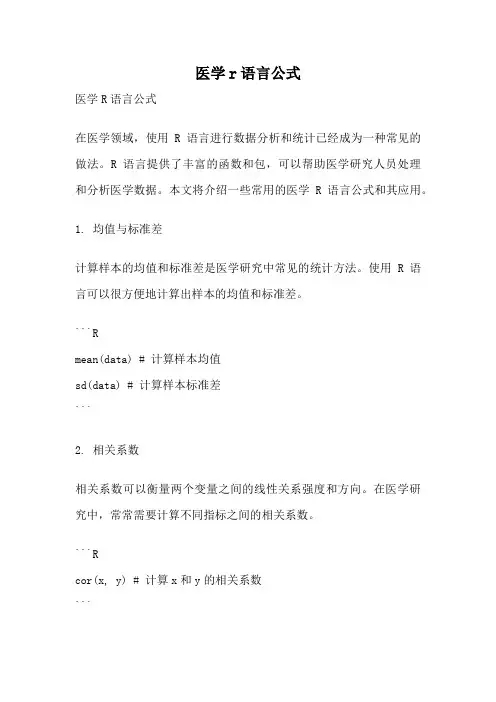
医学r语言公式医学R语言公式在医学领域,使用R语言进行数据分析和统计已经成为一种常见的做法。
R语言提供了丰富的函数和包,可以帮助医学研究人员处理和分析医学数据。
本文将介绍一些常用的医学R语言公式和其应用。
1. 均值与标准差计算样本的均值和标准差是医学研究中常见的统计方法。
使用R语言可以很方便地计算出样本的均值和标准差。
```Rmean(data) # 计算样本均值sd(data) # 计算样本标准差```2. 相关系数相关系数可以衡量两个变量之间的线性关系强度和方向。
在医学研究中,常常需要计算不同指标之间的相关系数。
```Rcor(x, y) # 计算x和y的相关系数```3. 线性回归线性回归是一种常用的统计方法,用于分析自变量和因变量之间的线性关系。
在医学研究中,可以利用R语言进行线性回归分析。
```Rlm(y ~ x) # 对y和x进行线性回归分析```4. 生存分析生存分析是医学研究中常用的分析方法,用于评估疾病发展的风险和预后。
R语言提供了多个包来进行生存分析,如survival包和survminer包。
```Rlibrary(survival)library(survminer)```5. 逻辑回归逻辑回归是一种常用的统计方法,用于分析因变量为二分类的情况。
在医学研究中,可以利用R语言进行逻辑回归分析。
```Rglm(y ~ x, family = binomial) # 对y和x进行逻辑回归分析```6. 方差分析方差分析是一种常用的统计方法,用于比较三个或更多个组之间的均值差异。
在医学研究中,可以利用R语言进行方差分析。
```Raov(y ~ x) # 对y和x进行方差分析```7. t检验t检验是一种常用的统计方法,用于比较两个组之间的均值差异。
在医学研究中,可以利用R语言进行t检验。
```Rt.test(x, y) # 对x和y进行t检验```8. 非参数检验非参数检验是一种不依赖于数据分布的统计方法,用于比较两个或多个组之间的差异。

R语言常用统计方法实现R语言是一种常用的统计分析工具,它提供了丰富的统计方法和函数,使得数据分析工作更加便捷和高效。
下面将介绍R语言中常用的统计方法,并给出相应的代码示例,共计26种统计方法。
1.描述统计分析:对数据进行描述性统计分析,包括均值、中位数、标准差、方差等。
```R#均值mean(data)#中位数median(data)#标准差sd(data)#方差var(data)```2.假设检验:用于检验数据的差异是否显著,包括t检验、方差分析、卡方检验等。
```R#t检验t.test(data1, data2)#单因素方差分析anova(data ~ factor)#卡方检验chisq.test(data)```3.相关分析:用于分析两个变量之间的相关性,包括皮尔逊相关系数、斯皮尔曼相关系数等。
```R#皮尔逊相关系数cor(data1, data2, method = "pearson")#斯皮尔曼相关系数cor(data1, data2, method = "spearman")```4.回归分析:用于建立变量之间的数学关系,并进行预测和解释。
```R#线性回归lm(dependent ~ independent, data)#逻辑回归glm(dependent ~ independent, data, family = binomial()```5.方差分析:用于分析不同组别之间的差异,包括单因素方差分析、多因素方差分析等。
```R#单因素方差分析aov(dependent ~ factor, data)#多因素方差分析aov(dependent ~ factor1 * factor2, data)```6.生存分析:用于分析事件发生时间及其相关因素,包括生存函数、生存曲线等。
```R#生存函数#生存曲线#生存回归分析```7.主成分分析:用于降维和提取数据中的主要信息。
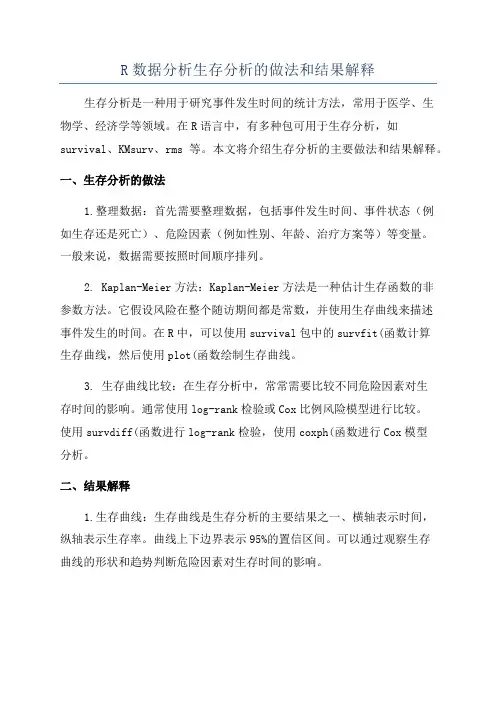
R数据分析生存分析的做法和结果解释生存分析是一种用于研究事件发生时间的统计方法,常用于医学、生物学、经济学等领域。
在R语言中,有多种包可用于生存分析,如survival、KMsurv、rms等。
本文将介绍生存分析的主要做法和结果解释。
一、生存分析的做法1.整理数据:首先需要整理数据,包括事件发生时间、事件状态(例如生存还是死亡)、危险因素(例如性别、年龄、治疗方案等)等变量。
一般来说,数据需要按照时间顺序排列。
2. Kaplan-Meier方法:Kaplan-Meier方法是一种估计生存函数的非参数方法。
它假设风险在整个随访期间都是常数,并使用生存曲线来描述事件发生的时间。
在R中,可以使用survival包中的survfit(函数计算生存曲线,然后使用plot(函数绘制生存曲线。
3. 生存曲线比较:在生存分析中,常常需要比较不同危险因素对生存时间的影响。
通常使用log-rank检验或Cox比例风险模型进行比较。
使用survdiff(函数进行log-rank检验,使用coxph(函数进行Cox模型分析。
二、结果解释1.生存曲线:生存曲线是生存分析的主要结果之一、横轴表示时间,纵轴表示生存率。
曲线上下边界表示95%的置信区间。
可以通过观察生存曲线的形状和趋势判断危险因素对生存时间的影响。
2.中位生存时间:生存曲线可以帮助估计中位生存时间,即有一半样本的生存时间小于等于该时间点,另一半样本的生存时间大于等于该时间点。
中位生存时间可以用作评估治疗效果的一个指标。
3. P值和风险比(Hazard Ratio):在生存分析中,通常会使用log-rank检验或Cox比例风险模型来比较不同危险因素对生存时间的影响。
log-rank检验可以得到一个P值,用于判断两个或多个组别之间生存情况是否存在显著差异。
Cox模型可以计算相对风险(Hazard Ratio),用于评估不同危险因素对生存时间的影响程度。
4. 危险比图:危险比图(Forest Plot)是显示危险比和其置信区间的图表。
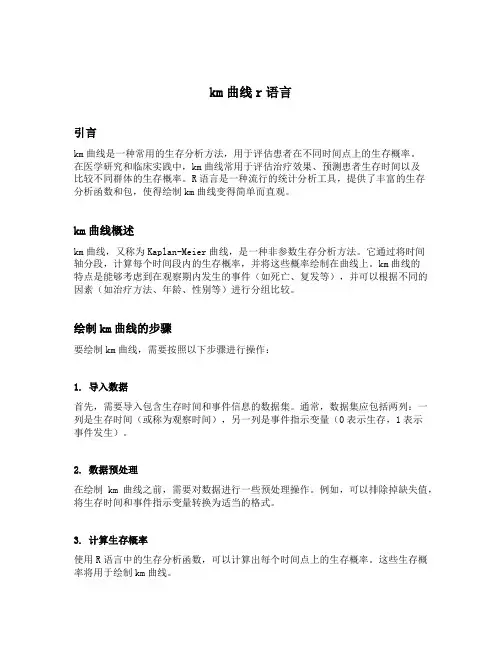
km曲线r语言引言km曲线是一种常用的生存分析方法,用于评估患者在不同时间点上的生存概率。
在医学研究和临床实践中,km曲线常用于评估治疗效果、预测患者生存时间以及比较不同群体的生存概率。
R语言是一种流行的统计分析工具,提供了丰富的生存分析函数和包,使得绘制km曲线变得简单而直观。
km曲线概述km曲线,又称为Kaplan-Meier曲线,是一种非参数生存分析方法。
它通过将时间轴分段,计算每个时间段内的生存概率,并将这些概率绘制在曲线上。
km曲线的特点是能够考虑到在观察期内发生的事件(如死亡、复发等),并可以根据不同的因素(如治疗方法、年龄、性别等)进行分组比较。
绘制km曲线的步骤要绘制km曲线,需要按照以下步骤进行操作:1. 导入数据首先,需要导入包含生存时间和事件信息的数据集。
通常,数据集应包括两列:一列是生存时间(或称为观察时间),另一列是事件指示变量(0表示生存,1表示事件发生)。
2. 数据预处理在绘制km曲线之前,需要对数据进行一些预处理操作。
例如,可以排除掉缺失值,将生存时间和事件指示变量转换为适当的格式。
3. 计算生存概率使用R语言中的生存分析函数,可以计算出每个时间点上的生存概率。
这些生存概率将用于绘制km曲线。
4. 绘制km曲线使用R语言中的绘图函数,可以将计算得到的生存概率绘制成km曲线。
通常,km曲线由一系列的水平线段和垂直线段组成,每个水平线段表示一个时间段内的生存概率,而垂直线段表示事件的发生。
R语言实现km曲线R语言提供了多个包和函数用于实现km曲线的计算和绘制。
以下是一些常用的R包和函数:1. survival包survival包是一个广泛使用的生存分析包,提供了计算km曲线的函数survfit()。
该函数可以根据生存时间和事件指示变量计算出生存概率,并返回一个survfit对象,该对象包含了生存概率和其他相关信息。
2. survminer包survminer包是一个用于生存分析数据可视化的包,提供了绘制km曲线的函数ggsurvplot()。
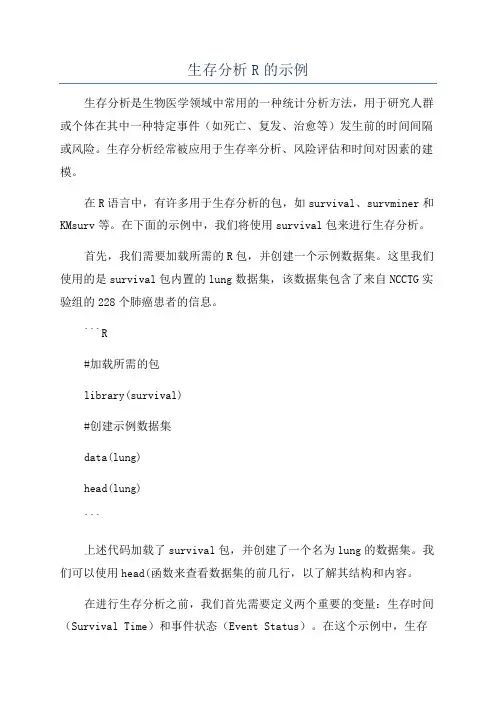
生存分析R的示例生存分析是生物医学领域中常用的一种统计分析方法,用于研究人群或个体在其中一种特定事件(如死亡、复发、治愈等)发生前的时间间隔或风险。
生存分析经常被应用于生存率分析、风险评估和时间对因素的建模。
在R语言中,有许多用于生存分析的包,如survival、survminer和KMsurv等。
在下面的示例中,我们将使用survival包来进行生存分析。
首先,我们需要加载所需的R包,并创建一个示例数据集。
这里我们使用的是survival包内置的lung数据集,该数据集包含了来自NCCTG实验组的228个肺癌患者的信息。
```R#加载所需的包library(survival)#创建示例数据集data(lung)head(lung)```上述代码加载了survival包,并创建了一个名为lung的数据集。
我们可以使用head(函数来查看数据集的前几行,以了解其结构和内容。
在进行生存分析之前,我们首先需要定义两个重要的变量:生存时间(Survival Time)和事件状态(Event Status)。
在这个示例中,生存时间是指患者从入组开始到死亡或失访(censoring)之间的时间间隔,事件状态是指患者是否已死亡(1表示死亡,0表示失访)。
接下来,我们可以画出生存曲线(Survival Curve),展示患者在不同时间点的生存概率。
```R#创建生存对象#画生存曲线```另外,我们可以根据不同的因素对生存曲线进行分组比较。
```R#根据性别分组比较生存曲线plot(survfit(lung_surv ~ sex, data = lung), xlab = "Time", ylab = "Survival Probability", main = "Survival Curve by Gender") #根据治疗方法分组比较生存曲线plot(survfit(lung_surv ~ rx, data = lung), xlab = "Time", ylab = "Survival Probability", main = "Survival Curve by Treatment")```上述代码中,我们使用~符号将生存对象lung_surv与不同的因素(如性别和治疗方法)进行分组比较。
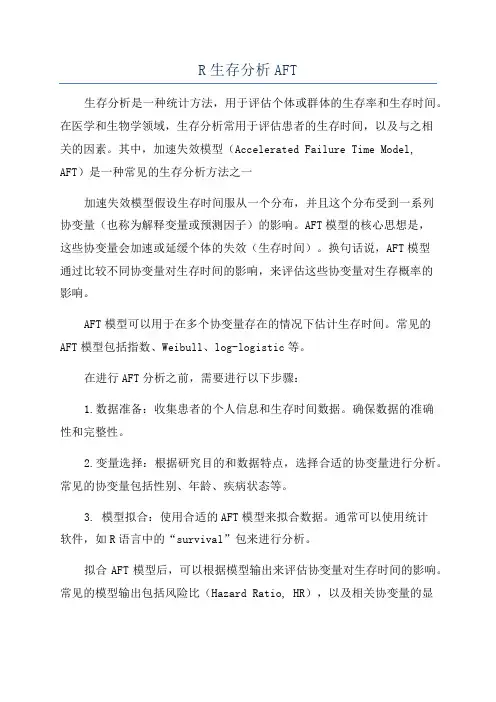
R生存分析AFT生存分析是一种统计方法,用于评估个体或群体的生存率和生存时间。
在医学和生物学领域,生存分析常用于评估患者的生存时间,以及与之相关的因素。
其中,加速失效模型(Accelerated Failure Time Model, AFT)是一种常见的生存分析方法之一加速失效模型假设生存时间服从一个分布,并且这个分布受到一系列协变量(也称为解释变量或预测因子)的影响。
AFT模型的核心思想是,这些协变量会加速或延缓个体的失效(生存时间)。
换句话说,AFT模型通过比较不同协变量对生存时间的影响,来评估这些协变量对生存概率的影响。
AFT模型可以用于在多个协变量存在的情况下估计生存时间。
常见的AFT模型包括指数、Weibull、log-logistic等。
在进行AFT分析之前,需要进行以下步骤:1.数据准备:收集患者的个人信息和生存时间数据。
确保数据的准确性和完整性。
2.变量选择:根据研究目的和数据特点,选择合适的协变量进行分析。
常见的协变量包括性别、年龄、疾病状态等。
3. 模型拟合:使用合适的AFT模型来拟合数据。
通常可以使用统计软件,如R语言中的“survival”包来进行分析。
拟合AFT模型后,可以根据模型输出来评估协变量对生存时间的影响。
常见的模型输出包括风险比(Hazard Ratio, HR),以及相关协变量的显著性水平。
HR表示两组个体之间的生存时间差异的相对大小。
HR大于1表示较高的失效风险,而HR小于1表示较低的失效风险。
此外,AFT模型还可以用于预测个体或群体的生存时间。
通过将协变量值代入模型,可以得出对应个体或群体的生存时间预测。
这对于医疗决策和患者管理具有重要意义。
需要注意的是,AFT模型的结果受到模型假设的限制。
特别是当数据中存在缺失值或截尾(censoring)时,需要采用合适的方法来解决这些问题。
同时,对于不同类型的数据,可能需要选择不同的AFT模型来进行分析。
因此,在进行AFT分析时,需要充分了解数据的特点,并选择合适的模型进行拟合。
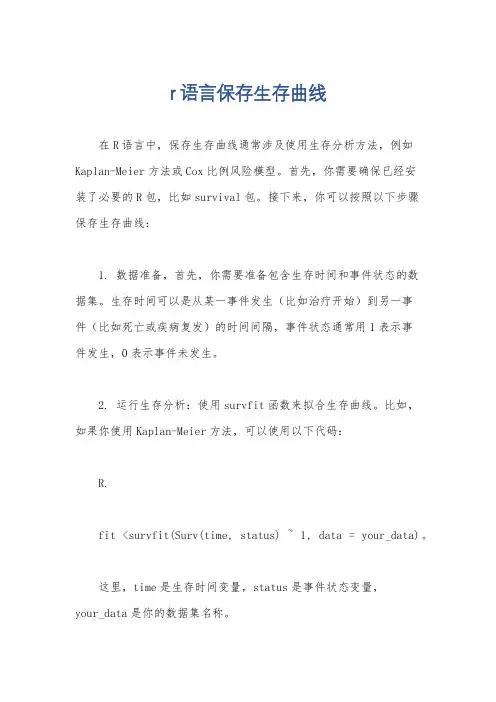
r语言保存生存曲线在R语言中,保存生存曲线通常涉及使用生存分析方法,例如Kaplan-Meier方法或Cox比例风险模型。
首先,你需要确保已经安装了必要的R包,比如survival包。
接下来,你可以按照以下步骤保存生存曲线:1. 数据准备,首先,你需要准备包含生存时间和事件状态的数据集。
生存时间可以是从某一事件发生(比如治疗开始)到另一事件(比如死亡或疾病复发)的时间间隔,事件状态通常用1表示事件发生,0表示事件未发生。
2. 运行生存分析:使用survfit函数来拟合生存曲线。
比如,如果你使用Kaplan-Meier方法,可以使用以下代码:R.fit <survfit(Surv(time, status) ~ 1, data = your_data)。
这里,time是生存时间变量,status是事件状态变量,your_data是你的数据集名称。
3. 可视化生存曲线:使用plot函数来绘制生存曲线图。
比如,可以使用以下代码:R.plot(fit, xlab = "Time", ylab = "Survival Probability", main = "Survival Curve")。
4. 保存生存曲线图:最后,你可以使用ggsave函数将生存曲线图保存为图片文件,比如PNG或者PDF格式。
比如,可以使用以下代码:R.ggsave("survival_curve.png", plot = last_plot(), device = "png")。
以上代码中,"survival_curve.png"是你想要保存的文件名,你也可以选择其他文件格式,比如PDF。
通过以上步骤,你就可以在R语言中保存生存曲线了。
希望这些步骤能够帮助到你。
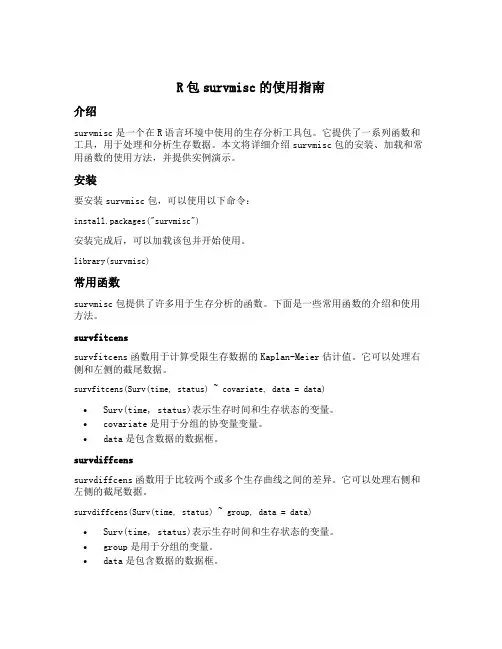
R包survmisc的使用指南介绍survmisc是一个在R语言环境中使用的生存分析工具包。
它提供了一系列函数和工具,用于处理和分析生存数据。
本文将详细介绍survmisc包的安装、加载和常用函数的使用方法,并提供实例演示。
安装要安装survmisc包,可以使用以下命令:install.packages("survmisc")安装完成后,可以加载该包并开始使用。
library(survmisc)常用函数survmisc包提供了许多用于生存分析的函数。
下面是一些常用函数的介绍和使用方法。
survfitcenssurvfitcens函数用于计算受限生存数据的Kaplan-Meier估计值。
它可以处理右侧和左侧的截尾数据。
survfitcens(Surv(time, status) ~ covariate, data = data)•Surv(time, status)表示生存时间和生存状态的变量。
•covariate是用于分组的协变量变量。
•data是包含数据的数据框。
survdiffcenssurvdiffcens函数用于比较两个或多个生存曲线之间的差异。
它可以处理右侧和左侧的截尾数据。
survdiffcens(Surv(time, status) ~ group, data = data)•Surv(time, status)表示生存时间和生存状态的变量。
•group是用于分组的变量。
•data是包含数据的数据框。
coxphcenscoxphcens函数用于拟合Cox比例风险模型,用于估计变量对生存的影响。
coxphcens(Surv(time, status) ~ covariate, data = data)•Surv(time, status)表示生存时间和生存状态的变量。
•covariate是用于分析的协变量变量。
•data是包含数据的数据框。
survAUCsurvAUC函数用于计算受限生存数据的时间相关区域下曲线(time-dependent AUC)。
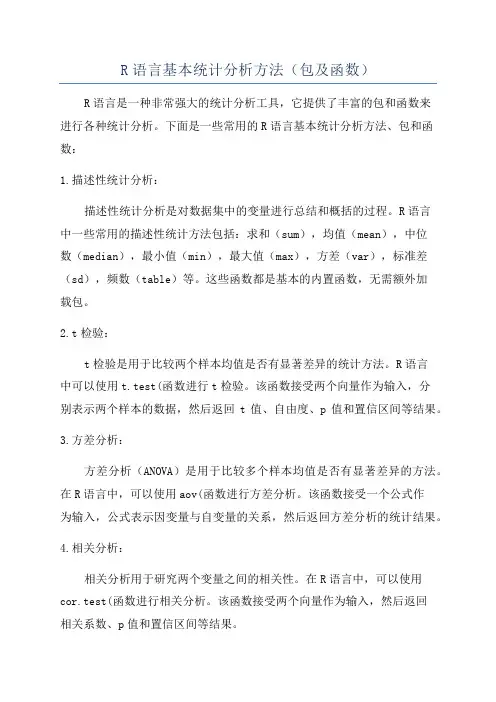
R语言基本统计分析方法(包及函数)R语言是一种非常强大的统计分析工具,它提供了丰富的包和函数来进行各种统计分析。
下面是一些常用的R语言基本统计分析方法、包和函数:1.描述性统计分析:描述性统计分析是对数据集中的变量进行总结和概括的过程。
R语言中一些常用的描述性统计方法包括:求和(sum),均值(mean),中位数(median),最小值(min),最大值(max),方差(var),标准差(sd),频数(table)等。
这些函数都是基本的内置函数,无需额外加载包。
2.t检验:t检验是用于比较两个样本均值是否有显著差异的统计方法。
R语言中可以使用t.test(函数进行t检验。
该函数接受两个向量作为输入,分别表示两个样本的数据,然后返回t值、自由度、p值和置信区间等结果。
3.方差分析:方差分析(ANOVA)是用于比较多个样本均值是否有显著差异的方法。
在R语言中,可以使用aov(函数进行方差分析。
该函数接受一个公式作为输入,公式表示因变量与自变量的关系,然后返回方差分析的统计结果。
4.相关分析:相关分析用于研究两个变量之间的相关性。
在R语言中,可以使用cor.test(函数进行相关分析。
该函数接受两个向量作为输入,然后返回相关系数、p值和置信区间等结果。
5.线性回归分析:线性回归分析用于建立一个线性模型来描述因变量和自变量之间的关系。
R语言中可以使用lm(函数进行线性回归分析。
该函数接受一个公式作为输入,公式表示因变量与自变量的关系,然后返回回归模型的统计结果。
6.非线性回归分析:非线性回归分析用于建立一个非线性模型来描述因变量和自变量之间的关系。
R语言中可以使用nls(函数进行非线性回归分析。
该函数接受一个公式和初始参数作为输入,然后返回拟合的非线性模型。
7.生存分析:生存分析用于研究时间数据和生存率之间的关系。
在R语言中,可以使用survival包进行生存分析。
survival包提供了一系列生存分析的函数,如生存曲线绘制、Kaplan-Meier法、Cox回归模型等。
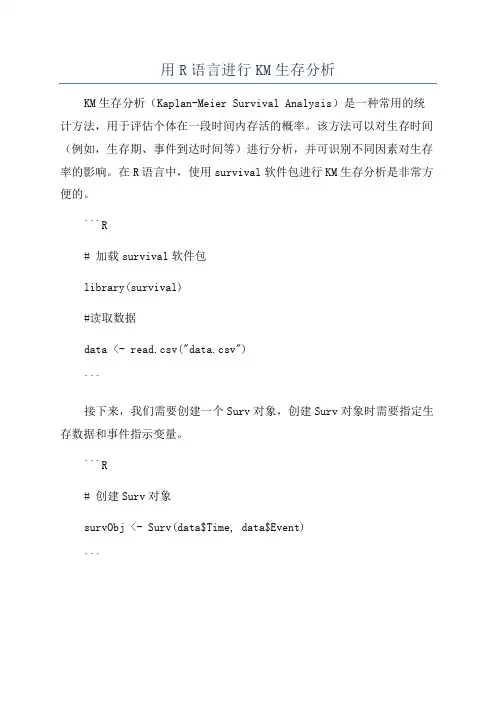
用R语言进行KM生存分析KM生存分析(Kaplan-Meier Survival Analysis)是一种常用的统计方法,用于评估个体在一段时间内存活的概率。
该方法可以对生存时间(例如,生存期、事件到达时间等)进行分析,并可识别不同因素对生存率的影响。
在R语言中,使用survival软件包进行KM生存分析是非常方便的。
```R# 加载survival软件包library(survival)#读取数据data <- read.csv("data.csv")```接下来,我们需要创建一个Surv对象,创建Surv对象时需要指定生存数据和事件指示变量。
```R# 创建Surv对象survObj <- Surv(data$Time, data$Event)```在执行KM生存分析之前,我们经常需要对数据集进行一些预处理步骤,以确保分析的可靠性。
例如,我们可以检查数据是否包含缺失值,并将其删除。
```R#检查缺失值sum(is.na(data$Time)) # 判断Time变量是否有缺失值sum(is.na(data$Event)) # 判断Event变量是否有缺失值#删除缺失值data <- na.omit(data)```一旦数据准备就绪,我们可以执行KM生存分析。
```RkmSurv <- survfit(survObj ~ 1, data=data)#打印KM估计结果print(kmSurv)#绘制KM生存曲线plot(kmSurv, xlab="Time", ylab="Survival Probability", main="KM Survival Curve")```除了基本的KM生存曲线之外,我们还可以比较不同组之间的生存概率差异。
例如,我们可以根据性别(Sex)和治疗方案(Treatment)对生存概率进行比较。
r语言km生存函数的点估计和区间估计-回复R语言是一种功能强大的统计计算和数据分析工具,其中的km生存函数(Kaplan-Meier Survival Function)是一种用于估计生存分析的方法。
在R语言中,我们可以使用survival包来计算km生存函数,并得出其点估计和区间估计。
本文将分步介绍如何使用R语言进行km生存函数的点估计和区间估计。
第一步是导入所需的R包。
在R中,我们需要首先导入survival包,该包提供了进行生存分析的函数和方法。
Rinstall.packages("survival") # 安装survival包library(survival) # 导入survival包第二步是导入数据。
在进行生存分析之前,我们需要准备包含观察时间和事件状态的数据。
观察时间指的是每个个体经历事件(例如死亡、失业、药物治疗)的时间点,而事件状态则指示该事件是否发生。
通常,观察时间和事件状态被存储在一个数据框中。
R# 创建一个包含观察时间和事件状态的数据框data <- data.frame(time = c(10, 15, 20, 22, 25, 27, 30),status = c(1, 0, 1, 0, 1, 0, 1))在上述示例中,我们创建了一个包含7个观察时间和对应事件状态的数据框。
其中,第1个观察时间为10,且事件发生(status为1);第2个观察时间为15,但事件未发生(status为0),依此类推。
第三步是使用survfit函数来计算km生存函数。
survfit函数可以通过传递数据框和适当的参数来生成km生存函数曲线。
R# 计算km生存函数survfit_km <- survfit(Surv(time, status) ~ 1, data = data)在上面的代码中,我们使用了Surv函数来创建km生存函数所需的时间和事件状态格式。
然后,我们运行了survfit函数,并将其保存在一个对象中(这里为survfit_km)。
临床生存特征筛选r语言
临床生存特征筛选R语言。
在临床研究中,生存分析是一种常用的统计方法,用于评估特定事件(如死亡、疾病复发等)发生的时间。
生存分析通常涉及到对一系列潜在的预测因素进行筛选,以确定对事件发生的影响。
在这个过程中,R语言成为了研究人员常用的工具之一,用于进行生存特征的筛选和分析。
R语言是一种开源的统计软件,具有强大的数据处理和分析功能,因此在临床生存分析中得到了广泛的应用。
下面将介绍一些在临床生存特征筛选中使用R语言的常见方法和技巧。
1. Cox比例风险模型。
Cox比例风险模型是生存分析中常用的模型之一,用于评估预测因素对事件发生的影响。
在R语言中,可以使用coxph函数来拟合Cox模型,并利用summary函数来查看模型的结果。
通过对模型系数的估计和显著性检验,可以筛选出对生存有显著影响的特征。
2. 生存曲线绘制。
生存曲线是生存分析的重要输出结果,用于描述事件发生随时间的累积情况。
在R语言中,可以使用survfit函数来生成生存曲线,并利用plot函数来进行可视化展示。
通过比较不同特征组之间的生存曲线,可以初步筛选出对生存有影响的特征。
3. 变量选择方法。
在实际应用中,数据通常包含大量的特征,而临床生存分析往往需要筛选出对事件发生具有显著影响的特征。
在R语言中,可以利用各种变量选择方法,如逐步回归、Lasso回归等,来进行特征筛选,从而得到最具预测能力的特征集合。
总之,R语言在临床生存特征筛选中具有重要的作用,研究人员可以利用其强大的数据处理和分析功能,对生存分析中的预测因素进行筛选和分析,从而为临床决策提供更可靠的依据。
r语言cox模型c指数及可信区间Cox模型是一种常用的生存分析方法,用于研究事件发生时间与危险因素之间的关系。
在Cox模型中,C指数是评估模型预测能力的重要指标之一,它可以帮助我们判断和比较不同危险因素对事件发生的影响程度。
在R语言中,我们可以使用survival包中的coxph()函数来拟合Cox模型,并得到相应的C指数及可信区间。
下面我们将介绍如何使用R语言进行cox模型分析,并解释C指数及可信区间的含义。
我们需要准备一份包含事件时间、事件状态和危险因素的数据集。
事件时间是指事件发生的时间点,事件状态是指事件是否发生的情况(例如,1代表事件发生,0代表事件未发生),危险因素是可能影响事件发生的变量。
假设我们的数据集名为data。
接下来,我们可以使用coxph()函数来拟合Cox模型,并得到C指数及可信区间的估计结果。
具体代码如下:```library(survival)model <- coxph(Surv(time, status) ~ variable1 + variable2, data = data)```在上述代码中,Surv(time, status)表示事件时间和事件状态,variable1和variable2是我们要考察的危险因素,data为数据集名。
通过运行这段代码,我们可以得到Cox模型的拟合结果model。
接下来,我们可以使用summary()函数来查看模型的摘要信息,其中包括C指数的估计值和可信区间。
具体代码如下:```summary(model)```运行上述代码后,我们可以在输出结果中找到C指数的估计值及其对应的可信区间。
C指数的估计值大于1表示事件发生的风险增加,小于1表示风险减少,等于1表示风险不变。
可信区间则提供了对C指数估计值的统计显著性检验,如果可信区间不包含1,则表明C指数估计值是显著的。
除了C指数,我们还可以通过模型的其他统计指标来评估模型的拟合优度和预测能力,例如log-likelihood、AIC和BIC等。
r语言固定点处组间生存率比较的统计
检验法
在R语言中,固定点处组间生存率比较的统计检验法有很多种,以下是其中的5种经典方法:
- 经典法。
- 对数转换法。
- cloglog 转换法。
- 反正弦转换法。
- logit 转换法。
这些方法通常用于比较两条生存曲线在某固定点处的生存率,通过实例分析发现,若使用组间生存曲线整体检验的 Log-rank 检验法或 Two-stage 检验法,很难对两组生存率比较给出合理的结果,而选取几个固定点进行检验时,可以得到固定时间点上组间生存率差异是否有统计学意义。
在这5种固定点时刻的检验方法中,以 cloglog 转换法的效果最佳。
请注意,具体的检验方法应根据数据的特点和研究的问题来选择,如果你需要进行这样的统计检验,建议寻求专业的统计学家或数据分析师的帮助。
R语言是一种用于统计分析和数据可视化的编程语言,而Kaplan-Meier生存函数(简称KM生存函数)是生存分析中常用的一种方法。
在进行生存分析时,我们常常需要对KM生存函数进行点估计和区间估计。
本文将对R语言中进行KM生存函数的点估计和区间估计进行详细介绍。
一、KM生存函数的点估计KM生存函数是描述随时间生存情况的一种非参数方法,它可以用于分析生存时间的分布和生存率。
在R语言中,我们可以使用survival包来进行KM生存函数的点估计,其中survfit()函数可以用来估计KM生存函数。
1. 使用survfit()函数进行KM生存函数的点估计我们需要加载survival包,并导入我们需要进行生存分析的数据。
假设我们的数据框名为data,其中包含了个体的生存时间和是否发生事件的信息。
接下来,我们可以使用survfit()函数对KM生存函数进行点估计,并得到生存曲线。
例如:```Rlibrary(survival)fit <- survfit(Surv(time, status) ~ 1, data = data)summary(fit)```在这段代码中,Surv()函数用来创建生存对象,time是生存时间,status表示是否发生事件。
survfit()函数则进行了KM生存函数的点估计,并将结果存储在fit中。
summary()函数可以用来查看点估计的结果。
2. 点估计结果的解释在得到点估计的结果后,我们可以通过summary()函数来查看估计的生存曲线以及相关的统计量。
KM生存函数的点估计结果通常包括了生存曲线、生存时间的中位数、25和75分位数等信息。
这些信息可以帮助我们直观地了解样本的生存分布情况。
二、KM生存函数的区间估计除了点估计,我们也常常需要对KM生存函数进行区间估计,以了解估计结果的不确定性范围。
在R语言中,我们可以使用conf.int参数来进行区间估计,得到生存曲线的置信区间。
CRAN Task View: Survival AnalysisMaintainer: Arthur Allignol and AurelienLatoucheContact:arthur.allignol at uni-ulm.deVersion:2016-01-27Survival analysis, also called event history analysis in social science, or reliability analysis in engineering, deals with time until occurrence of an event of interest. However, this failure time may not be observed within the relevant time period, producing so-called censored observations.This task view aims at presenting the useful R packages for the analysis of time to event data.Please let theStandard Survival Analysis Estimation of the Survival DistributionKaplan-Meier:The survfit function from the packagedata.(replacement of the Design package) proposes a modifiedversion of the survfit function. The package implements afast algorithm and some features not included inestimator are implemented in the package.plot.Surv ofpackage plots the Kaplan-Meier estimator. The packageleft-censored data.svykm in provides a weighted Kaplan-Meierestimator.nested.km in estimates the survival curve for each level of categorical variables with missing data.The kaplan-meier function in computes the Kaplan-Meierestimator from histogram data. The package permits tocompute a weighted Kaplan-Meier estimate. The KM function inpackage plots the survival function using a variant of theThe package computes presmoothed estimates of thedensity functions. The package permits to compute theThe package provides several functions for computingconfidence procedure). The package offers varioususing the package. The package implements the ∙(NPMLE):The package provides several ways to compute thepermits to compute the NPMLE ofThe icfit function in package computes the NPMLE forinterval-censored data. The implements several algorithms∙Parametric:The package permits to fit an univariateThe package provides routines for fitting models in the Hazard Estimation∙The package permits to estimate the hazard function through∙The epi.insthaz function from computes the instantaneous∙and allow to estimate the hazard function∙The package aims at estimating the hazard function for interval∙The package provides non-parametric smoothing of the Testing∙The survdiff function in compares survival curves using theFleming-Harrington G-rho family of test.implements this∙implements a permutation version of the logrank test and a∙The implements the shift-algorithm by Streitberg and possibly for censored data.∙SurvTest in the package implements the logrank test∙The package performs tests using maximally selected rank∙The package implements logrank and Wilcoxon type tests for ∙package.∙∙implements a two stage procedure for comparing hazard∙The package proposes to test the equality of two survival∙The package offers several tests based on the∙The package provides a logrank test for which aggregated ∙survival data can be found in the package.Regression Modelling∙Cox model:The coxph function in the package fits the Coxmodel.cph in the package and the package propose someextensions to the coxph function. The package implements the Firth's penalised maximum likelihood bias reduction method for theregression can be found in package proposesa robust implementation of the Cox model.timecox infits Cox models with possibly time-varying effects. Thefits Cox models for covariates withsurvey design using the svycoxph function inThepackageICM-algorithm. The package implements Pan's (2000)data. Thetransformation model. TheThe package implements the Cox model using an activeThe package fits Cox models using maximum penalised baseline hazard function.The cumres function in computes goodness-of-fit methods for the Cox proportional hazards model. The proportionality assumption canbe checked using the cox.zph function incalculates concordance probability estimate for the Cox model, asdoes the coxphCPE function in coxphQuantile in the latterfunction of covariates. The package computesother parametric survival models. The package permits toIn particular, it provides support forthe coxph,survreg and coxme functions. The package on Bioconductor proposes a resampling based multiple hypothesis testing that can be applied to the Cox model. Testing coefficients ofTheThe package provides hazard ratio curves that allows forThe package permits to compute the unadjusted/adjustedThe∙Parametric Proportional Hazards Model:survreg(fromThe and packages implement a proportional hazardsmodel with a parametric baseline hazard. The pphsm in translatesan AFT model to a proportional hazards form. The package includes the hare function that fits a hazard regression model, usingnecessarily, proportional. The package implements the model for the baseline survival function, and proportional hazards,proportional odds or probit functions for regression.∙Accelerated Failure Time (AFT) Models:The survreg function inpackage can fit an accelerated failure time model. Amodified version of survreg is implemented in the package(psm function). It permits to use some of the functionalities.The package also proposes an implementation of the AFT model (function aftreg). An AFT model with an error distribution assumedthe package. The package proposes the front end of the survreg function for left-censored data. A least-squarethe package. The package implements theused when covariates are subject to measurement error. A robustin package fits AFT models forestimating equations) to the AFT model.∙Additive Models:Both and fit the additive hazards model of Aalen in functions aareg and aalen,respectively.also proposes an implementation of theYing (1994) goodness-of-fit for Cox regression models) and thepartly parametric additive risk model of McKeague and Sasieni. Aavailable in the package.∙Buckley-James Models:The bj functionin and BJnoint in compute the Buckley-James model,though the latter does it without an intercept term. The packageboosting, regression trees and boosted MARS, elastic net).∙Other models:Functions like survreg can fit other types of models depending on the chosen distribution,e.g., a tobit model.The package provides the tobit function, which is a wrapperof survreg to fit the tobit model. An implementation of the tobit modelthe package. The package provides implementationmodel. The package fits the inverse Gaussian distribution tobarrier hitting time of a Wiener process, where drift towards theThe package computes the pseudo-observation for modellingrestricted mean.fits parametric time-to-event models, inprobability, and where one of the parameters is a linear function ofcovariates. The Icens function in package provides ainterval-censored data. The package can fit vector generalisedThe package implements the generalised additive modelThe locfit.censor function in produces local regressionestimates. The crq function included in the packageTheregression model is implemented in the package. Aster models,and packages.Theva package, fitsformulation. Thetime data. The packages proposes somecumulative hazards, quantiles and restricted mean.Multistate ModelsGeneral Multistate Models:The coxph function frompackage can be fitted for any transition of a multistate model.correspondence between multistate models and time-dependentcovariates. Besides, all the regression methods presented above can be used for multistate models as long as they allow forThe package provides convenient functions for estimating andTheThe package provides non-parametric estimation forand left-truncation. The package permits to estimate hazardsmultistate models. The package contains functions for fittingbe modelled in terms of covariates. The package can beused to fit semi-Markov multistate models in continuous time. The distribution of the waiting times can be chosen between theexponential, the Weibull and exponentiated Weibull distributions.TheThe package extends the package tothepackage permits to fit Cox models to the progressiveThe package fits proportional hazards models for the toward the transient state. Left-truncated and right-censored data are also allowed. The model is either parametric (Weibull) orsemi-parametric with M-splines approximation of the baselineThe package implements Lexis objects as a way to represent,Thecomputes the expectedCompeting risks:The package estimates the cumulative samples. The package also implements the Fine and Gray model forextends the package to stratified and clustered data.Thecumulative incidence functions. The package implementsPackage computes pseudo observations for modellingfunctions.does flexible regression modelling for competingand direct binomial regression approach.implementsdata. The package estimates the conditional probability of aimplements a proportional-odds model using either the temporalprocess regression or the pseudo-value approaches.Packages(via survfit) and can also be used toestimate the cumulative incidence function. The packagepackage implements acovariate-dependent censoring. The package implementsmodel for interval censored data.∙Recurrent event data:coxph from the package can be used toanalyse recurrent event data. The cph function of the package fitsfitted with the package. The latter also permits to fit jointevent. The package proposes implementations of severalPeñestimation under a Gamma Frailty model. The packageThe package implements weighted logrank type tests for Relative Survival∙The package proposes several functions to deal with relative survival data. For example,rs.surv computes a relative survivalcurve.rs.add fits an additive model and rsmul fits the Cox model ofAndersen et al. for relative survival, while rstrans fits a Cox model∙The package permits to fit relative survival models like the∙The package implements methods for population-based and the join point relative survival model.∙The package computes relative survival, absolute excess∙The package permits to fit multiplicative regression models∙The package implements time-dependent ROC curves and Random Effect Models ∙Frailties:Frailty terms can be added in coxph and survreg functionsin packagethe package. The two.stage function in the packagefits the Clayton-Oakes-Glidden model. The package fits fullyThe package fits proportional hazards models with ausing a penalised likelihood on the hazard function. The package also fits additive and nested frailty models that can be used for, e.g.,meta-analysis and for hierarchically clustered data (with 2 levels ofeffects can be fitted using the package. The package fits athe package. The package implements a linear mixeddistributions.∙data:The package allows the analysis of repeatedmodels.Multivariate Survival Multivariate survival refers to the analysis of unit, e.g., the survival of twins or a family. To analyse such data, we can estimate the joint distribution of the survival times∙Joint modelling:Both and can estimate bivariate∙The package implements various statistical models forincidence models, bivariate random effects probit models,∙The package constructs trees for multivariate survival data using Bayesian Models∙The package proposes an implementation of a bivariate∙The package computes a Bayesian model averaging for Cox∙The DPsurvint function in fits a Bayesian semi-parametricAFT model.LDDPsurvival in the same package fits a LinearDependent Dirichlet Process Mixture of survival models.∙NMixMCMC in performs an MCMC estimation of normal mixtures for censored data.∙ A MCMC for Gaussian linear regression with left-, right- or interval-censored data can be fitted usingthe MCMCtobit in∙The package estimates the hazard function from censored∙The weibullregpost function in computes the log∙The fits generalised linear mixed models using MCMC∙The package aims at drawing inference on age-specificrecords have missing information on times of birth and death.∙The package performs joint modelling of longitudinal and ∙Bayesian parametric and semi-parametric estimation forthe package.∙priors.∙The package fits a Bayesian parametric proportional hazards∙The package implements Bayesian clustering using a∙The package provides Bayesian model fitting for several process mixture model, anovaDirichlet process mixture model,proportional hazards model and marginal spatial proportional hazards∙The package implements non-parametric survival High-Dimensional Data∙Recursive partitioning:can perform logicregression.The package implements trees and bagged trees for∙implements bagging for survival data.The∙Regularised and shrinkage methods:TheTheshrinkage is available inpackage implementsThepackageregularisation.fits Cox models with penalized ridge-type ∙the package. The package includes a generic gradientmodels for right-censored data.implementsvalue of high-dimensional data. It is basedon provides routines for fitting the Cox∙Other:Thepackage can construct indextraining dataset. The package fits Cox proportionalmethod.provides partial least squares regression and variousThe package implements feature selection algorithms based on algorithm for predicting survival risk.Predictions and PredictionPerformance∙The package provides utilities to plot prediction error curves for∙implements prediction error techniques which can be∙The package permits to estimate time-dependent ROC∙computes time-dependent ROC curves and Akritas's nearest neighbour estimation method (Cumulative∙implements time-dependent ROC curves, AUC and∙Various time-dependent true/false positive rates andthe∙package provides several functions to assess and∙package.∙Thefor comparing competing risks prediction models.∙The package provides functions forsurvival data.Power Analysis∙The package proposes power calculation for weighted Log-Rank∙The permits to calculate sample size based on proportional∙The package provides power and sample sizeepidemiological studies).∙Power analysis and sample size calculation for SNP associationthe package.Simulation∙The package permits to generate data wih one binary∙The package permits the user to simulate complex survival∙The package proposes some functions for simulating∙The package also permits to simulate and analyse multistate transition hazard functions, for non-Markov models and for∙The package provides functions for simulating complex∙The package implements tools for simulating and plotting∙The package permits to simulate simple and complex∙The package provides routines for performing for the microsimulation are a multistate model, Markov ornon-Markov, for which the transition intensities are specified, as well as an initial cohort.GraphicsThis section tries to list some specialised plot functions that might be useful in the context of event history analysis.∙Theextends this to the competing risks model.∙The plot.Hist function in permits to draw the states and∙The package provides many plot functions for representing∙The package provide multistate-type graphics for competing event to each competing event describes the particular amount ofevery incidence rate.Miscellaneous∙is the companion package to "Dynamic Prediction in Clinical∙Package proposes the censboot function that implements several∙The package estimates the current cumulative∙The package provides functions for performing∙provides tools for individual patient data meta-analysis,∙The package includes the data sets from Klein andcan be found in the thatDavidson (2003) and∙The package permits to construct, validate and calibrate∙The package compute the MLE of a density (log-concave)∙The package fits parametric Transform-both-sides∙The package implements algorithms to detect outliers∙The package implements an EM algorithm to CRAN packages:∙∙∙∙∙∙∙∙∙∙∙∙∙∙∙∙∙∙∙∙∙∙∙∙∙∙∙∙∙∙∙∙∙∙∙∙∙∙∙∙∙∙∙∙∙∙∙∙∙∙∙∙∙∙∙∙∙∙∙∙∙∙∙∙∙∙∙∙∙∙∙∙∙∙∙∙∙∙∙∙∙∙∙∙∙∙∙∙∙∙∙∙∙∙∙∙∙∙∙∙∙∙∙∙∙∙∙∙∙∙∙∙∙∙∙∙Related links:∙CRAN Task View:∙CRAN Task View:∙CRAN Task View:∙∙∙∙∙∙∙∙∙∙。